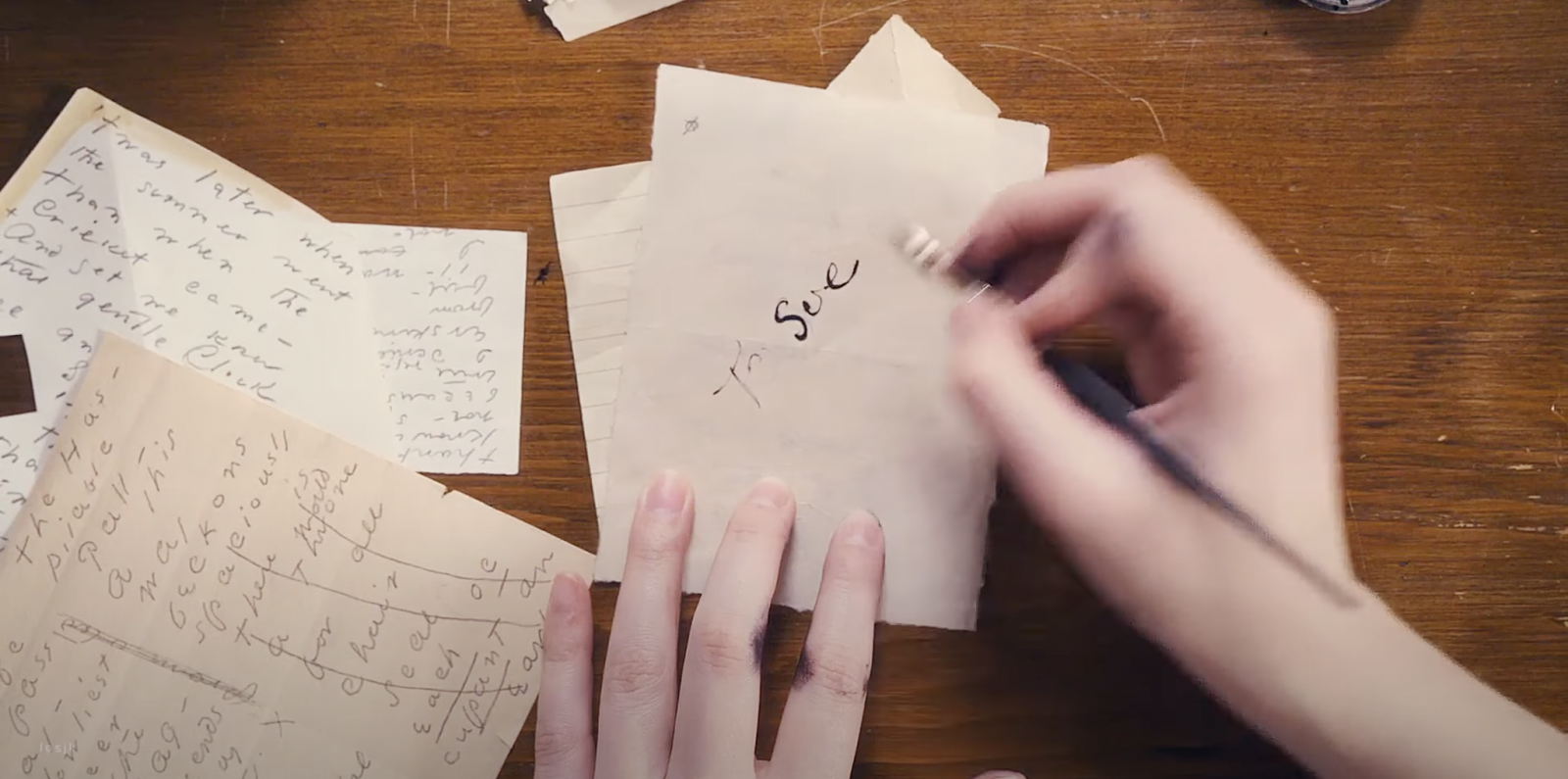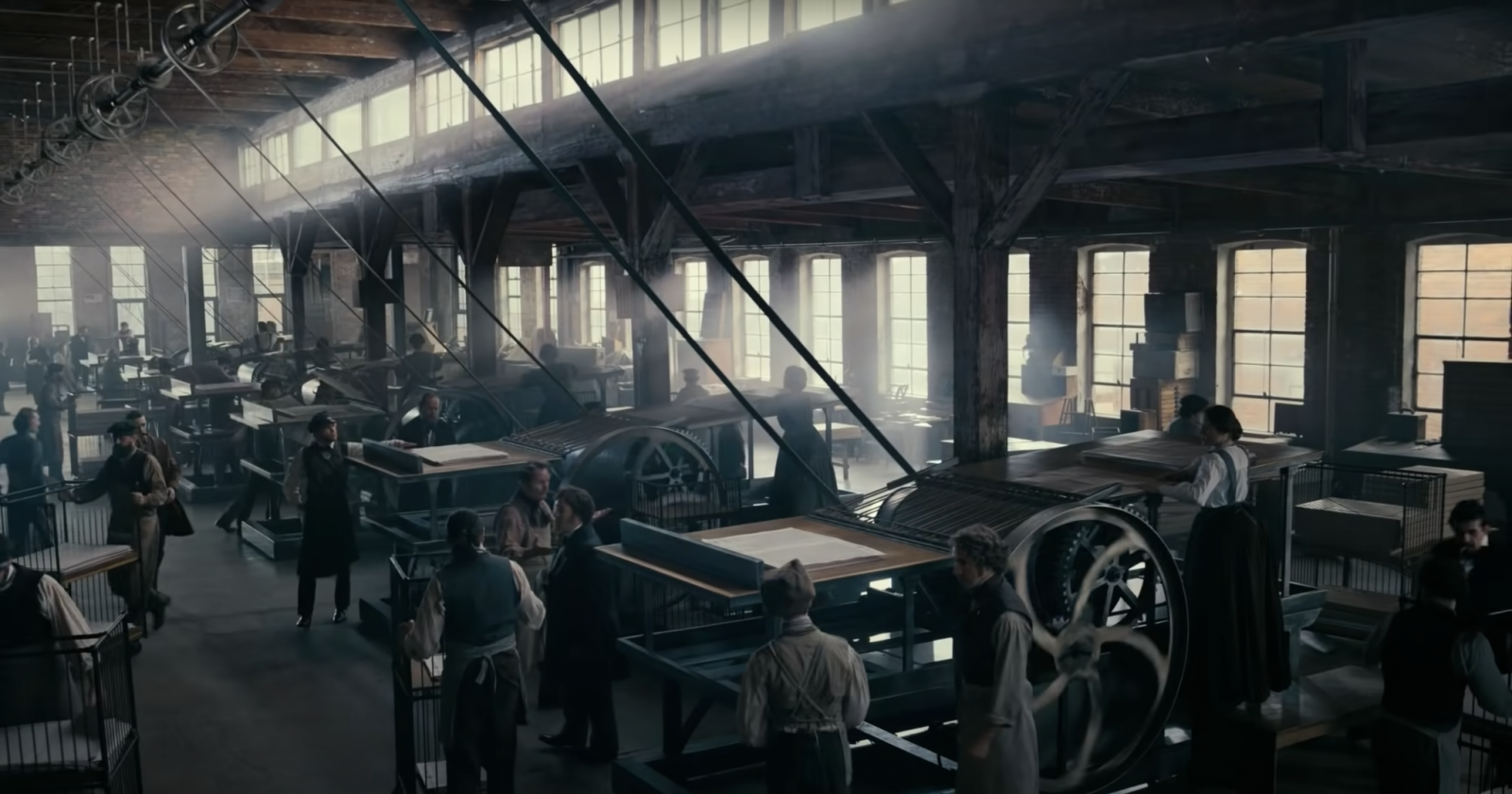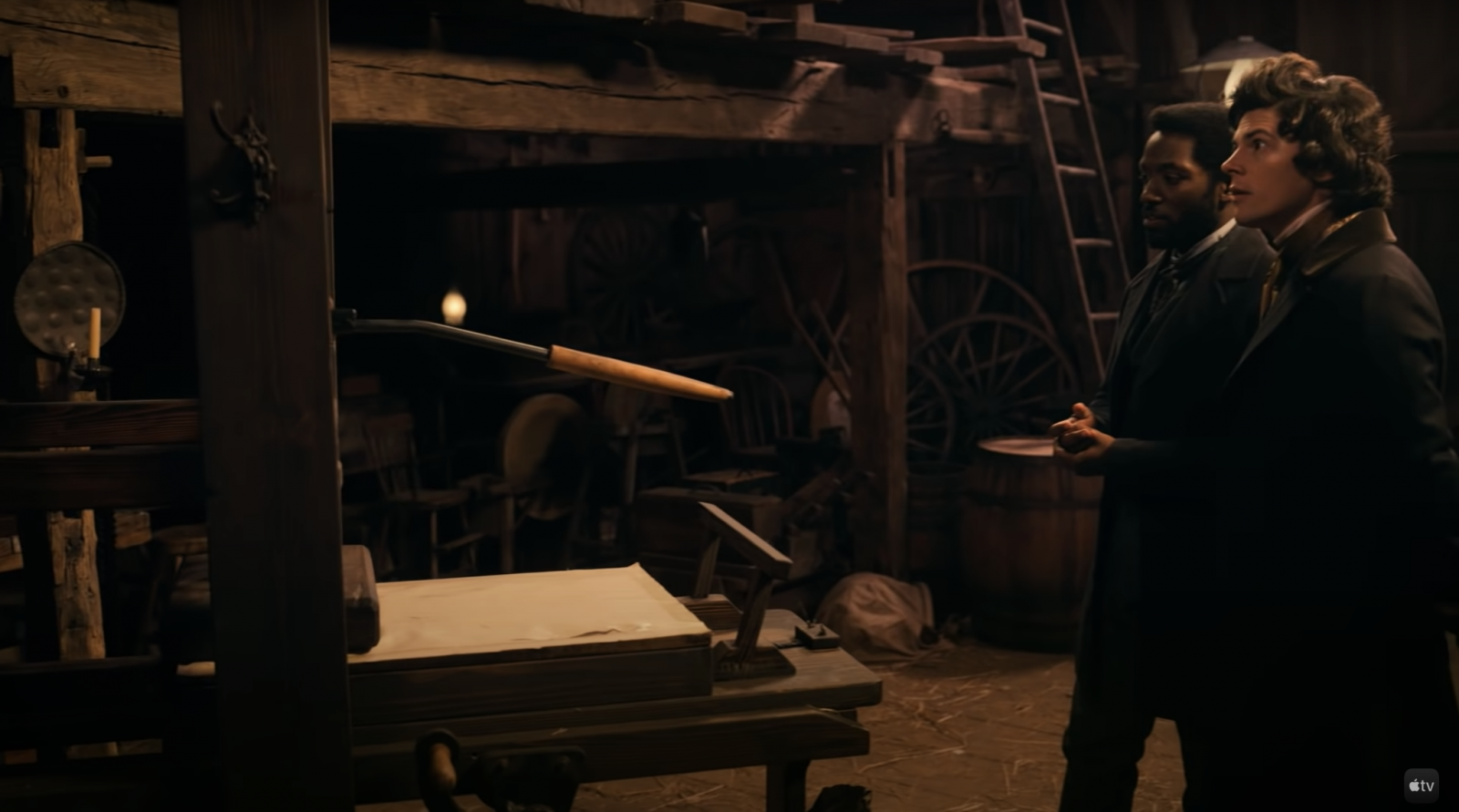- The Ghosts of Emily Dickinson: Hauntings in Popular Culture
- Introduction: Which Dickinson? by Jeannette Schollaert
- Specters on Screen
- Big Reputations: Celebrity and Temporal Duration in/of Dickinson Lyrics by Elizabeth Dinneny
- Ghosts in the Algorithm: The Dickinsons on TikTok by Elizabeth Dinneny
- "Dickinson-core" by Jeannette Schollaert
- Contributors
- Works Cited
Dickinson’s (In)visible Emily by Elizabeth Dinneny
It’s not often that an author gets their own television series. Even more rare is the literary TV series that receives multiple seasons and critical acclaim. Alena Smith’s Dickinson, an Apple TV+ series, boasts two successful seasons and is currently in production for a third and final season. Dickinson follows Emily Dickinson (Hailee Steinfeld) in her early twenties, just beginning to publish (in the second season) and living a full, social life. The series might come as a shock to those who learned and believe that Dickinson was a spinster who pined after men from the safety of her bedroom. The series’ creator, Alena Smith, knows this well, and the show’s first episode opens with a familiarly sterile monologue from Steinfeld, transcribed here:
“Emily Dickinson was born in 1830 in Amherst, Massachusetts. She lived throughout her life in her father’s house. Near the end of her life, she rarely left her room. Aside from a few mostly anonymous verses, she remained unpublished. When she died, her poems were discovered. Some of the strangest, most fascinating poems ever written. Almost two-thousand of them, hidden in a maid’s trunk.”
The camera cuts to Emily, who gets out of bed to write before being interrupted by her sister, Lavinia (Anna Baryshnikov), who tells her to fetch water. Emily asks why Austin (Adrian Blake Enscoe) won’t do it, and Lavinia responds, “he’s a boy.” Emily Dickinson replies: “This is such bullshit” (“Because I could not stop”).
On-screen apparitions of Dickinson are nothing new. The difference between Alena Smith’s Dickinson and most of these representations is that Dickinson's Emily does not pretend to be true. Rather, this comedic autofiction portrays a Dickinson with archival precedence, but without any presuppositions that its main character is the real thing. For example, this Dickinson takes seriously the archival evidence of Emily’s intimate relationship with her sister-in-law, Susan Huntington Dickinson (Ella Hunt), but it does not pretend to know every detail of their lives. Instead, it takes up their spirits—playful, curious, imaginative—and places them in situations that might or might not have happened. Best of all: it doesn’t matter. When Emily and Susan (or, EmiSue) put on men’s clothes to the sound of Lizzo’s “Boys” and crash a college lecture on volcanoes, the ‘truth’ of the scene is of no consequence (“I have never seen ‘Volcanoes’”). Would the “real” Emily and Susan have done so, if they could? It’s not out of the question, and the catharsis of watching Emily Dickinson, a figure so sanitized, heterosexualized, and insulated, given a full and comedic life only heightens the viewer’s experience of Dickinson’s many jokes and jabs. Defendants of the conservative Dickinson should pause before accusing Alena Smith of not doing her reading; she has read every Dickinson biography and plenty of Dickinson and Civil War scholarship to get a handle on Emily, the Dickinsons, and their world before representing it on the screen (McHenry). Dickinson animates the archive.
In Dickinson’s second season, Emily Dickinson struggles with her desire to be published and the demands of the commercial. Its first episode opens, like the first season, with a voiceover as the audience is shown photos, poems, and letters from Dickinson’s archive. This time, Ella Hunt provides the prologue: “The records of Emily Dickinson’s life, up to and including Austin and Susan’s marriage, are full and factual compared to what lies ahead. Over the next few years, just a handful of letters survive. The truth, perhaps, is hidden in her poems” (“Before I got my eye put out”). Dickinson reminds us that the truth is partial; we only know what is left of the archive and what we interpret those remnants to be. As images of the poems spin out of view, the Springfield Republican’s printing room transitions onto the screen, contrasted against Emily Dickinson’s handwritten and “private” poetry. While her friends and family begin to read the paper as it’s delivered to them, Emily writes furiously at her desk, throwing scraps of paper, labeled “to Sue,” into a basket that Maggie (Darlene Hunt) delivers to Susan, or “Mrs. Dickinson” (“Before I got my eye put out”).

Fig. 1. Image description: Emily signing what is likely a letter-poem, “To Sue,” adjacent to other handwritten poems and notes scattered on a scratched wooden desk. Apple TV+.
Throughout this second season, the Springfield Republican will prove significant to several members of the Dickinson family. While Susan connects Emily with editor Sam Bowles (Finn Jones), who will eventually publish Emily’s poetry in the paper, Edward Dickinson (Toby Huss) sees the paper as an investment opportunity. After informing investors Edward and Austin Dickinson of John Brown—whom Bowles calls “a celebrity”—and his raid on Harper’s Ferry, Bowles suggests a civil war is imminent, and “it could be good for us” (“I Like a Look of Agony”). When Austin protests, Sam makes the implicit explicit: “War sells papers, my friend. War sells papers.”
If war sells papers, so too do papers sell wars. Dickinson incorporates a fictional abolitionist newspaper based in Amherst and supported by Austin Dickinson. The Constellation, most likely a nod to Boston’s abolitionist paper The North Star, is printed in the Dickinsons’ barn and functions as a foil to the Springfield Republican (The North Star). While Samuel Bowles sees John Brown’s celebrity and the potential war as good for business, Henry (Chinaza Uche), editor of The Constellation, and his comrades see these events as significant moments in the path toward abolition. Their paper does not seek personal profit, nor does Henry seek fame. Rather, The Constellation operates in secret with the goal of raising money and spreading abolitionist writing to end slavery. This contrast becomes obvious in the season’s eighth episode, which opens, again, with the Springfield Republican’s printing room and distribution (“I’m Nobody!”). A few moments later, we cut to Henry, who hides copies of The Constellation in a crate of grapes. In the moment he passes off the crate for transport, he is handed the Republican, with Emily’s first published poem on the front page, and which he delivers to the Homestead. Emily picks up the paper and says, “Immortality. Holy shit.”

Fig. 2. Image Description: The Springfield Republican printing room, massive and populated by workers and multiple presses. The dark room is lit by walls of windows, through which sunlight shines on the papers-in-print. Apple TV+.

Fig. 3. Image Description: Henry and Austin in the Constellation printing and meeting room (the Dickinson barn), after the delivery of its single press. The barn is small, filled with miscellaneous tools, and is dimly lit. Apple TV+
Emily’s immorality-by-print (though, of course, the poems printed during her lifetime did not achieve her fame) starkly contrasts with the Constellation’s secret printing and the (im)mortality of “Nobody” (Will Pullen), the ghost of a Union soldier who haunts Emily from the future. For nearly the entire episode, Emily is invisible to everyone but Nobody (“I’m Nobody!”). It seems as a result of her brief fame, Emily briefly becomes a living ghost. Only seen by each other, the two discuss the advantages and disadvantages of invisibility. Having secretly observed people reading and critiquing her poem, Emily is troubled. She asks Nobody, “Everybody just gets to talk about me regardless whether or not what they say is true?” The line is tongue-in-cheek, for viewers know that the small comments this invisible Emily hears are nothing compared to the praise, criticism, and interpretations that her poetry and life will endure. In response, Nobody tells Emily, “Fame, it’s kind of like death.” Dickinson’s poetry makes a similar comment on fame: “Fame is the one that does not stay — / It’s occupant must die” (Fr1507). Dickinson allows the poet to experience a glint of the fame-in-death that she has today.
While Emily and Nobody enjoy the privacy afforded by physical invisibility, some in Amherst achieve invisibility in hiding. Following her conversation with Nobody, Emily discovers a Constellation meeting in the barn. Henry gives a speech about the critical role of their newspaper in raising funds and spreading information for antislavery efforts: “Our money may have bought their weapons, but our words have given them strength!” In this discussion of the power of print, Henry “Box” Brown (Ade Otukoya) (Brown), a performer, suggests that Hattie’s (Ayo Edebiri) “ghost stories” are not included in those strength-giving words. She responds, “My little ‘ghost stories’ have subtext. I use the gothic genre to ask critical questions about women’s experiences” (“I’m Nobody!”). Fiction, and ghost stories in particular, here, enable criticism of very real circumstances. While we never get to read Hattie’s ghost stories, we can imagine what their Black feminist and abolitionist assertions of womanhood in the antebellum era might look like.[1] The Constellation’s members experience a celebrity different from Emily’s: their fame aids abolition, but it could also mean actual death. Henry finishes his speech by disregarding celebrity and underscoring the paper’s goal: “What we are doing here is claiming our right to exist. Our writing, our newspaper is changing the world. It is changing the entire fate of this country. And though we may be anonymous today, tomorrow, we will not be invisible.” Though the Constellation is a fictional paper, Henry is right; civil war is imminent, and records of abolitionist newspapers will endure and be studied hundreds of years after their publication for their vital impact on the antislavery movement and the beginning of the Civil War. The choice to be in/visible, Dickinson shows us, is a privilege.
Notes
[1]Ghosts, hauntings, and the gothic have been mobilized in Black feminist writing for social critique, as in Octavia Butler’s work and Toni Morrison’s Beloved. For more on ghosts as social manifestations, see Avery Gordon’s Ghostly Matters: Haunting and the Sociological Imagination.



